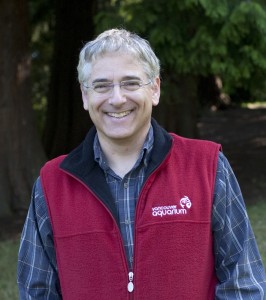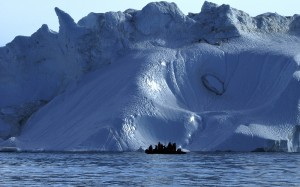Author: Eric Solomon
A few hundred of Canada’s leading Arctic researchers are converging on Vancouver this week for the annual ArcticNet Scientific Meeting. If you were an Arctic nerd like me, you’d be pretty excited. But even if you’re not “Arctically” inclined (it’s my blog post so I get to make up new words), you should probably be paying attention. That’s because what goes on in the Arctic affects all of us, whether in the North or the South. And what goes on down here affects what happens in the North as well.
For 150 years or so, western scientists have been travelling to and studying the Arctic. Yet what I find particularly interesting, if not a bit frightening is how much we still have to learn about the Arctic—at least scientifically. In an ideal world, scientifically speaking, we would study the basics about a particular region like the Arctic and develop a good understanding of how it works before moving on to more complicated questions. In its early years, Arctic science was asking the kinds of questions one might ask when studying a “new” ecological region: What lives here? What role does ice play in the ecosystem? What are the patterns of freezing and melting in the Arctic?
Many of those questions, of course, might have been answered sooner had early Arctic scientists consulted the Northern Peoples. For at least 5,000 years, people have lived in the Far North. The environmental knowledge gained over that time and passed on from one generation to the next is immense—in both quantity and value. This ecological knowledge is an important source of information about the past and the present in the Arctic, but it also has its limitations.
Over the last several decades, scientists and Northerners began to recognize that things were changing rapidly in the North. Those who have grown up in the Canadian Arctic can point to numerous examples of how much has changed since they were young—environmentally, socially, politically, culturally and economically. Many Inuit Elders have stories to tell about how the ice used to be thicker and safer for travel, how animals that were once abundant are no longer seen, and ground that was once stable has thawed and slumped into the sea.
As “change” became the central theme in political, social, cultural and environmental Arctic dialogues, the nature of scientific questions changed as well. For the last 30 to 40 years, the scientific community has been asking a series of “what if” questions – What if the temperature continues to rise? What if we continue to see less sea ice every year? What if permafrost begins to thaw even faster?
Amidst all this change, researchers have still been scrambling to get a baseline understanding of the Arctic as it is today, or at least as it was yesterday. Nobody expected so much change so quickly. The Arctic of 2012 is already significantly different than it was just 30 years ago and it continues to see rapid and intense climatic and ecological change. Last week, the National Oceanic and Atmospheric Administration (NOAA) released its annual Arctic Report Card for 2012. I won’t scare you with a lot of statistics, but the bottom line is we’ve gone from “if things change,” to “when things change,” and we’ve arrived with a thud at “as things change.”
When you get a group of Arctic scientists together in a room, it becomes quickly apparent that we are participating in a race that started while we were still lacing our shoes and stretching. It’s nobody’s fault that we’re this far behind, but we do have a lot of catching up to do.
Is the sky falling? I don’t think so. Neither do many in the North who are quick to point out to me that they’ve been looking outside every morning and adapting to what they see for millennia, and they’ll continue to do so. But their world is and will continue to be different than it was just a few decades ago. And so will yours and mine, because the ice and climate in the Arctic has a great deal of power over what kind of summers and winters we experience down here.
One goal of the scientific community now is to understand these changes—what they are, what they impact, and what we can do about it. Here at the Vancouver Aquarium, we work mostly on the latter two. We collaborate on research that seeks to understand the impact that the changing northern climate is having on important species, and we work hard to help the Canadian public understand our role in all of this.
Most of us won’t be out in the field conducting scientific studies of ice and tundra, but we can play an active role. In fact, we already do. The question is whether that role is positive or negative, intensive or minimal. We’re adding to the problem when we burn fossil fuels or otherwise contribute warming gasses to the atmosphere; we’re subtracting from the problem when we think carefully about the daily purchases we make, how we get around, how we exercise our vote and, importantly, how we inform ourselves about these issues.
Given the choice, I’ll take the positive.
Eric Solomon is the Director of Arctic Programs for the Vancouver Aquarium in Vancouver, British Columbia.


Thanks for your comment, Greenheart.
The issue I have with assigning blame for where we are now is that one could easily point in any direction and make a reasonable case. It is important to understand how we’ve arrived at this unfortunate place for several reasons. But I’m also very aware that speaking in terms of blame can quickly polarize the dialogue. We all shoulder the responsibility for the situation we’re in to some extent.
I’m not familiar with your background in climate and environmental science, but your perception of those working to understand the issues is quite different from mine. As I write this, I’m at the ArcticNet Annual Scientific Meeting. While there may still be a few “old school” scientists that choose not to or are unable to make the connections between their specific research questions and the implications for “the big picture”, those folks are hard to find these days. In fact, the predominant themes of both the International Polar Year conference earlier this year and this one, are very explicitly about the big picture connections that concern you.
Regarding whether “the sky is falling”, two nights ago, I moderated a public forum on the future of the Arctic with two of the leading Arctic change scientists in Canada. Dr. David Barber predicted that the Arctic would be free from summer ice by 2020. That’s truly alarming. Dr. Louis Fortier described, as he has many times before, the social, political, economic, cultural and nutritional implications. But it is a matter of human psychology that when we perceive a problem to be so much bigger than us, we tune it out. There is sufficient research (and my own personal experience) to show that the most effective way to reach those we need to reach is to avoid invoking a sense of panic and hopelessness–the kind that is frequently likened to running around yelling, “The sky is falling!”
Urgency? Absolutely. But panic won’t lead to the real solutions-oriented dialogue and action we so desperately need.
Great post, until Eric Soloman got to the “It’s nobody’s fault that we’re this far behind” line. Of course it’s somebody’s fault. And scientists must shoulder a good bit of the blame, for two reasons. First, at the end of the first IPCC meeting (1990, was it?), the attending scientists (as reported by a Greenpeace attendee) decided not to tell the full truth because they were afraid policymakers would throw up their hands and do nothing. The second reason is that the sciences tend to be (a) reductionist and (b) elitist. So not only are scientists sometimes not the best at seeing the whole picture (e.g., impacts of Arctic meltdown on northern hemisphere agriculture and food security), but those in physics and chemistry tend to view the life sciences with disdain, so they don’t think in terms of food and water and ecosystems and life.
Whence your “Is the sky falling? I don’t think so.” Look around! We’re only a few bad Arctic summer sea ice years away from vast crop failures in the northern hemisphere, which was once thought to be impervious to the negative impacts of global warming (or at least the last to be impacted). Once that albedo is gone, and once that latent heat of melting is unleashed elsewhere, yikes! I’m glad that northern inhabitants think they can survive a warming of +3ºC and higher (we’re committed to that already, according to Robert Watson, and the IPCC doesn’t include carbon feedbacks from Arctic wetlands and thawing permafrost, according to UNEP, let alone destabilizing methane hydrates). The other 7.5 billion of us have, unfortunately, evolved into an agricultural species that is dependent on a stable climate if we want to eat.